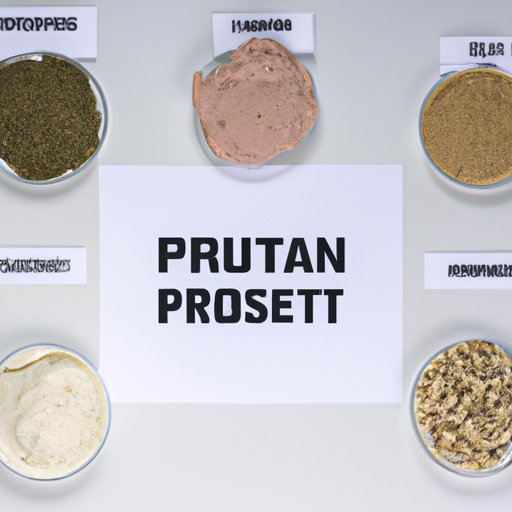
I. Introduction
Protein is often viewed as the ultimate macronutrient when it comes to overall health, fitness, and body composition. However, how much protein can you actually absorb in one meal? Is there a limit to how much protein the body can process and utilize? This article delves into the science behind protein absorption, the differences between plant-based and animal-based proteins, the timing of protein consumption, protein needs for different demographics, common myths surrounding protein consumption, and practical tips for maximizing protein intake.
II. The Science behind Protein Absorption
One of the most critical processes that occur in the body is the digestion and absorption of nutrients. Protein absorption is crucial for ensuring that the body receives the necessary amino acids that are required for muscle growth, repair, and maintenance.
The digestive system’s process of protein absorption starts in the stomach, where it is broken down into smaller peptide chains. Once it reaches the small intestine, it undergoes further breakdown into amino acids, which are then transported to the liver. From here, these amino acids can either be used for immediate energy or stored for later use in the muscles and other tissues.
Protein digestion and absorption rates vary depending on the protein’s source, its quantity, and the individual’s digestive health. Generally, whey protein has a faster absorption rate than casein, and animal-based proteins tend to be absorbed more efficiently than plant-based proteins.
Research suggests that the body can absorb anywhere from 20 to 30 grams of protein per meal. The body’s ability to absorb protein is limited, and it cannot absorb an infinite amount of protein at once. Consuming more protein than the body can handle may result in digestive discomfort, bloating, and unused amino acids being excreted.
III. Differences between Plant-Based and Animal-Based Proteins
Plant-based and animal-based proteins differ in their nutrient composition, digestive process, and overall impact on health. While both types of proteins can be used by the body, they have unique characteristics that affect protein absorption rates.
Animal-based proteins, such as beef, poultry, and fish, have a complete amino acid profile, meaning they provide all essential amino acids that the body needs. They are also easily digestible and have a high biological value, meaning they are readily absorbed by the body.
Plant-based proteins, such as legumes, nuts, and soy products, may not have a complete amino acid profile and may require pairing with complementary proteins to ensure that the body receives all required essential amino acids. They also tend to be less easily digestible and may have a lower biological value than animal-based proteins.
While plant-based diets can meet protein requirements, it may be challenging to consume enough protein to maintain muscle mass and promote muscle synthesis. Vegetarians and vegans may need to consume supplements or consume protein-rich plant-based foods to meet their daily protein needs.
IV. Timing of Protein Consumption
The timing of protein consumption is critical for maximizing absorption and muscle synthesis. Consuming protein-rich meals or snacks before and after exercise can enhance muscle protein synthesis and recovery.
The amount of protein to consume per day varies depending on the individual’s goals, body weight, age, and activity level. As a general guideline, consuming 1.6 grams of protein per kilogram of body weight per day may help support muscle growth and repair.
The timing of protein consumption may also differ depending on the individual’s demographics. Athletes, weightlifters, and active individuals may benefit from consuming protein-rich meals or snacks before and after exercise to aid recovery and muscle synthesis. The elderly may require more frequent protein consumption to prevent muscle loss and maintain overall health. Children/teens and vegetarians/vegans may need to consume more protein than the average adult to meet their body’s growth and development needs.
V. Protein Needs of Different Demographics
Protein requirements vary depending on the individual’s demographic. Different groups of people have different protein needs based on their body composition, level of physical activity, and overall health.
Athletes and weightlifters may require more protein to support their muscle growth and recovery. The elderly may need to consume more protein to prevent muscle loss and maintain overall health. Vegetarians and vegans may need to consume protein-rich plant-based foods or supplements to meet their daily protein needs fully. Children/teens may need to consume more protein than the average adult to support their bodies’ growth and development needs.
These demographics’ unique protein needs should be taken into account when designing their daily diets to ensure that they are consuming enough protein to meet their specific requirements.
VI. Debunking Common Myths
Common myths surround protein consumption, ranging from the idea that consuming high amounts of protein will lead to muscle gain to the notion that plant-based proteins are inferior to animal-based proteins.
However, research has debunked many of these myths. Consuming too much protein does not necessarily result in muscle gain, and plant-based proteins can be just as effective in promoting muscle growth and repair as animal-based proteins.
VII. Practical Tips for Spreading Protein Intake
Incorporating protein-rich snacks in daily life can help spread out protein intake throughout the day. Snacks like Greek yogurt, hard-boiled eggs, and protein bars can provide a quick and convenient protein source.
On-the-go protein options like protein powder, ready-to-drink protein shakes, or single-serving nut butter packets can be handy for busy days and help ensure that the body receives enough protein even when meal planning is not possible.
VIII. Conclusion
This article has explored the science behind protein absorption, differences between plant-based and animal-based proteins, protein needs for different demographics, and common protein consumption myths. It is essential to understand how much protein the body can absorb in one meal and how different protein sources can affect absorption rates and overall health. By incorporating some of the practical tips for maximizing protein intake, readers can optimize their diets and ensure that they are getting enough protein to support their overall health and fitness goals.





